It is unfortunate that the History textbook prepared by NCERT for the students of class XI written by Prof Satish Chandra is full of distortions and wrong statements. In the previous edition of Medieval India, prescribed for class XI, Shri Chandra, referring to the martyrdom of Guru Tegh Bahadur quoting some Persian source, had written that after his return from Assam, the Guru in association with one Hafiz Adam, a follower of Shiekh Ahmed Sirhandi, had resorted to plunder and rapine laying waste the whole province of the Punjab.
There was a lot of protest from the historians, well conversant with the Sikh history against this statement. Dr Hari Ram Gupta in his book, History of the Sikhs (Part-1) has written on page 205 that Sayyed Ghulam Hussain of Lucknow wrote in his Persian book in 1782 that Guru Tegh Bahadur and Hafiz Adam, a disciple of Shiekh Ahmed Sirhandi, had collected a large body of men. They moved about in countryside and seized money and material by force. Prof. Satish Chandra based his statement on this source, which was written more than one hundred years after the martyrdom of Guru Tegh Bahadur totally ignoring the contemporary evidence.
Moreover, Hafiz Adam was banished by Shahjahan in 1642?33 years earlier. Hafiz went on pilgrimage to Mecca and Madina where he died in 1643. How could Guru Tegh Bahadur join hands with such a person? With such superfluous knowledge of history, Satish Chandra not only belittled the martyrdom of Guru Tegh Bahadur, but also showed his bias for Sikhs and their history.
After that Satish Chandra modified his writing a little, keeping his bias and frivolousness. In the edition of 2005 (Page 297-299) of the same book, he say, "We are told that Aurangzeb was annoyed because the Guru had converted a few Muslims to Sikhism."
Who told this story to Satish Chandra? He has not given the source of his information. Historians like Sir Jadunath Sarkar, Dr Indu Bhushan Banerjee, Dr Hari Ram Gupta or Dr Ganda Singh have not mentioned that Guru Tegh Bahadur had converted some Muslims to Sikhism. Secondly, he fully denies the historical fact that there was a large-scale religious persecution of Hindu Pandits in Kashmir under the governorship of Iftekhar Khan. In his previous version he fully refuted the fact that Kashmir Pandits visited Guru Tegh Bahadur at Anandpur and gave him the details of the situation in their state. Changing his previous view Satish Chandra in the new version of the book states, "However, there is evidence to show that the Guru received a delegation of Brahmins from Kashmir and promised to support them."
It is strange that Prof. Chandra always tries to save Aurangzeb, for his policy of religious persecution. In the case of the martyrdom of Guru Tegh Bahadur, he does not accept the truth of holding Aurangzeb responsible for it. The great historian Sir Jadunath Sarkar has clearly mentioned this fact in his famous book, History of Aurangzeb (Page 313) in following words, "He (Guru Tegh Bahadur) encouraged the resistance of the Hindus of Kashmir to forcible conversion to Islam and openly defied the Emperor. Taken to Delhi he was cast in prison and called upon to embrace Islam and on his refusal was tortured for five days and then beheaded on warrant from the Emperor."
Dr Indu Bhushan Banerjee in his book, Evolution of Khalsa (part 2, page 60-61) has said that it was a self-sought martyrdom for the cause of protecting Kashmiri Pandits from the religious persecution.
The references given in the NCERT book regarding Guru Gobind Singh are not only misleading but also show the utter lack of knowledge and perspective of the Sikh history.
There is no doubt that after facing the attack of the joint forces of hills?Rajas and Mughals?for several months the Guru decided to leave the fort of Anandpur. The commanders of Mughal forces were regularly sending messages to the Guru that if he left the fort, no harm would be done to him. Guru Gobind Singh left the fort with his family and a few hundred Sikhs. The Guru’s convoy had hardly covered a few miles, when Mughal and allied forces, forgetting their promises, attacked the Guru. The saga of the battle of Chapkam is well known. While crossing the swollen river Sirsa, the Guru got separated from his family. His two elder sons, Ajit Singh and Johar Singh separated from his family. They died fighting the enemy. Two younger sons, Jorawar Singh and Fateh Singh were captured by the Subedar of Sirhand and on their refusal to embrace Islam, were bricked alive at Sirhand.
It is also not historically correct that while the Guru was staying at Talwandi, he was not disturbed. In this period Guru Gobind Singh fought his last battle with Mughal forces at the field of Khidrana (now known as Muktasar) where enemy forces were badly beaten.
As I have mentioned earlier, Satish Chandra is very kind to Aurangzeb (equally unkind to Sikh history). In the latest edition of Medieval India, he says, "It is doubtful whether the dastardly action of Wazir Khan against the sons of the Guru was carried out at the instance of Aurangzeb." Why this is doubtful? Guru Gobind Singh himself had blamed Aurangzeb for the killing of his four sons in his letter written to him while he was in Deccan.
The problem with Satish Chandra is that he totally lacks historical perspective and always bases his statements on hearsay. His arguments start with the phrases like, "it is doubtful", "according to some", "We are told", etc. Such phrases are not used in writing the history. The history is written on the basis of credible evidences. The absurdity of the notions of Prof. Satish Chandra is proved by the statement made by him in the book when he writes, "According to some, he (the Guru) had hoped to persuade Aurangzeb to restore Anandpur to him."
No historian has mentioned such a thing. If Satish Chandra had read the full text of Zafarnama, the letter written by Guru Gobind Singh to Aurangzeb, he would not have committed this mistake. In his letter the Guru had rebuked the emperor for his inhumanly behaviour towards his father and brothers and condemned him for his lifestyle.
I feel extremely sorry that NCERT should engage a person like Prof. Satish Chandra, whose intellectual integrity is so much under question to write a history book for our young children and misguide them.
(The author is a noted historian and columnist.)
Do you want your children to study this?
Our ancestors were beef-eaters.
They were foreign invaders.
The great martyrs who sacrificed their lives for freedom of the country were terrorists.
The students of 11th class will study a lesson on Maqbool Fida Husain, the bigot painter who displayed goddess Durga, Saraswati and even Bharatmata in nude.
Mira, a symbol of liberated Indian womenhood, used to dance in the streets.
Swami Dayananda was called a hired preacher of Christians, anti-religious and atheist.
The NCERT books have all this and much more
Is it not the insult of our history, dharma and national heroes?
If it is, should it be tolerated silently?
http://www.organiser.org/dynamic/modules.php?name=Content&pa=showpage&pid=137&page=23#2

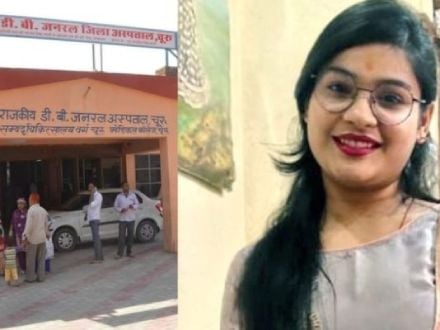 Rajasthan: Woman found hanging at a beauty parlour, Arshad, 3 others booked
Rajasthan: Woman found hanging at a beauty parlour, Arshad, 3 others booked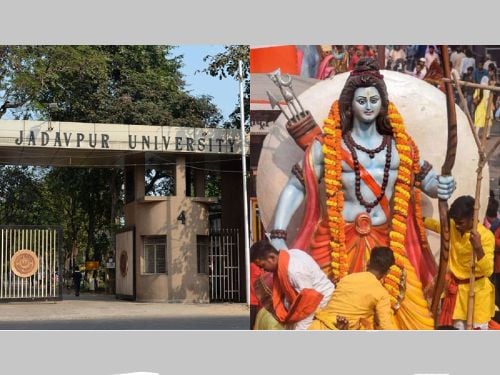 Jadavpur Univ revokes permission to celebrate Ram Navami on campus after granting it
Jadavpur Univ revokes permission to celebrate Ram Navami on campus after granting it Andhra Pradesh: Farooq kills mentally challenged Hindu man for insurance money
Andhra Pradesh: Farooq kills mentally challenged Hindu man for insurance money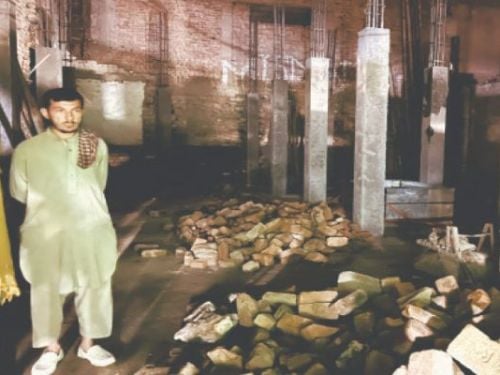 Pakistan: Ancient Hindu temple in Khyber Pakhtunkhwa demolished for commercial complex
Pakistan: Ancient Hindu temple in Khyber Pakhtunkhwa demolished for commercial complex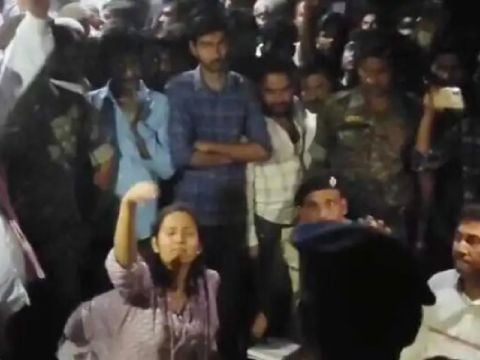 Bihar: Goddess Bhagavati Temple in Araria vandalised and deities damaged
Bihar: Goddess Bhagavati Temple in Araria vandalised and deities damaged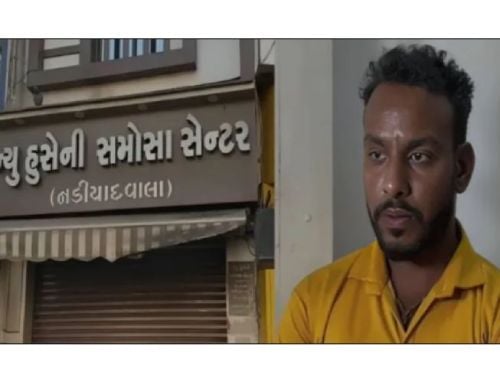 Vadodara: Beef supplier Imran Qureshi arrested in beef-stuffed samosa case
Vadodara: Beef supplier Imran Qureshi arrested in beef-stuffed samosa case